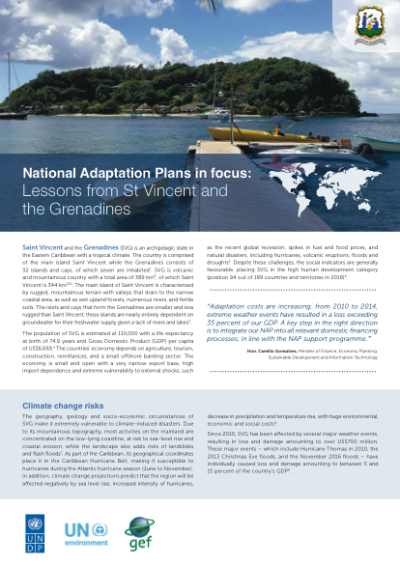Saint Vincent and the Grenadines

Saint Vincent and the Grenadines is an island archipelago located in the Caribbean Sea. With a total land area of 340 square kilometers and 84 kilometers of coastline, the nation consists of over 30 islands, inlets, and cays, some of which are privately owned (MHE, 2000; USDS, 2010). The country’s climate is tropical and the terrain of its islands are volcanic and mountainous (USDS, 2010). The main island of Saint Vincent is characterized by rugged, mountainous terrain with valleys that drain to the narrow coastal area, as well as wet upland forests, numerous rivers, and fertile soils (MHE, 2000). The islets and cays that form the Grenadines are smaller and less rugged than Saint Vincent; these islands are nearly entirely dependent on groundwater for their freshwater supply given a lack of rivers and lakes (MHE, 2000).
The country’s population is approximately 104,500, with adult literacy at 88.1 per cent and per capita Gross Domestic Product approximately US$18,100 (USDS, 2010). The country’s economy is highly dependent on tourism and agricultural production; approximately 60 per cent of the workforce is employed by banana production, and the industry accounts for 50 per cent of the island nation’s exports. Efforts to diversify the economy have been made in recent years (USDS, 2010).
St. Vincent and the Grenadines First National Communication was completed in 2000 and was prepared in conjunction with the regional programme for the Caribbean: Planning for Adaptation to Global Climate Change (CPACC). As part of this initiative, a climate-monitoring station was established off the southwest coast of St. Vincent to compile a historical record of environmental change. The country also participated in a series of regional efforts to establish database and information systems, inventory coastal resources and uses, and formulate a policy framework for integrated coastal and marine management. Pilot studies were done on coral-reef monitoring for climate change, coastal vulnerability and risk assessment, economic valuation of coastal and marine resources, and formulation of economic/regulatory proposals.
Specific adaptation measures that have been/are being pursued by St. Vincent and the Grenadines include:
- Revision and enforcement of the Town and Country Planning Act, establishing land use as a high priority with sound land-use controls along with flexibility to address the dynamic aspects of long-term shoreline retreat and climatic change.
- Strengthening of the building codes and the initiation of builder certification to assure that adequate construction standards are being met.
- The development of a thorough vulnerability assessment as a basis for land-suitability and hazard mapping.
- The formulation of a coastal management programme with permitting authority and incentive-based criteria for coastal development that sends the right signals to the development community.
- Agricultural reform that promotes a strong, viable agricultural base able to adapt to changing climatic conditions, including the development of in situ seed-bank and tissue-culture development centres for the preservation of plant genetic information.
- Protection of water-supply sources and improved harnessing and distribution systems to accommodate competing uses with increasing water demand and water supply variability.
- The enhancement of water quality, addressing municipal and industrial discharges and urban and agricultural runoff.
- An expansion of the country’s environmental education programme that speaks to climate change, vulnerability, sustainability , human health, and safety.
- The provision of incentives for investment in renewable energy, including solar and wind energy and hydrogen-fuel-based transportation.
- The strengthening and equipping of the local vector-control unit to respond to expanding insect populations and the emergence or re-emergence of vector-borne diseases.
- Greater emphasis on heritage and eco-tourism to supplement beach tourism.

